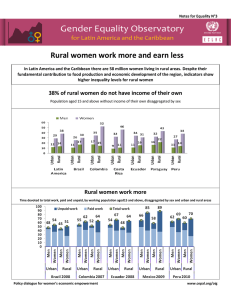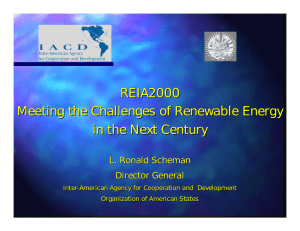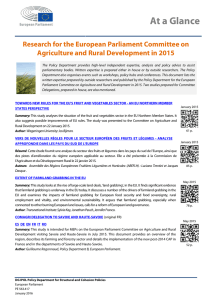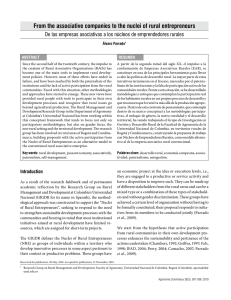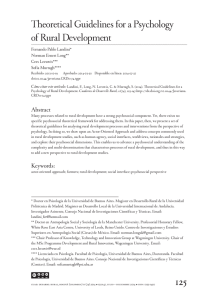The leader Programme and the Rise of Rural Development in Spain
Anuncio
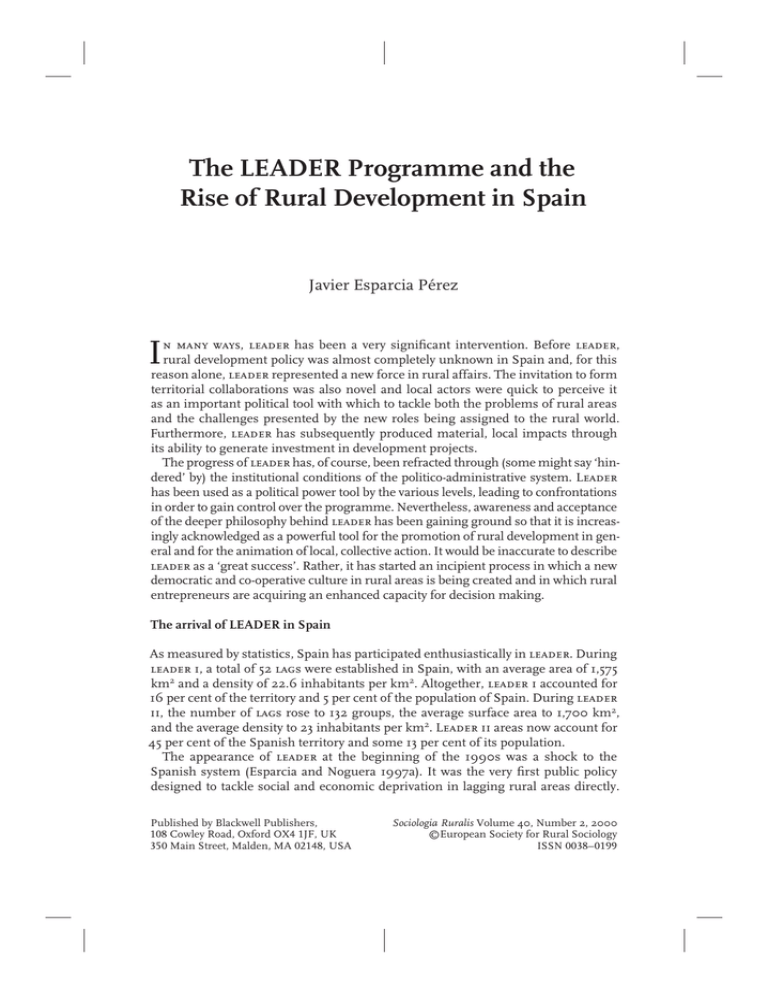
The LEADER Programme and the Rise of Rural Development in Spain Javier Esparcia Pérez I n many ways, leader has been a very significant intervention. Before leader, rural development policy was almost completely unknown in Spain and, for this reason alone, leader represented a new force in rural affairs. The invitation to form territorial collaborations was also novel and local actors were quick to perceive it as an important political tool with which to tackle both the problems of rural areas and the challenges presented by the new roles being assigned to the rural world. Furthermore, leader has subsequently produced material, local impacts through its ability to generate investment in development projects. The progress of leader has, of course, been refracted through (some might say ‘hindered’ by) the institutional conditions of the politico-administrative system. Leader has been used as a political power tool by the various levels, leading to confrontations in order to gain control over the programme. Nevertheless, awareness and acceptance of the deeper philosophy behind leader has been gaining ground so that it is increasingly acknowledged as a powerful tool for the promotion of rural development in general and for the animation of local, collective action. It would be inaccurate to describe leader as a ‘great success’. Rather, it has started an incipient process in which a new democratic and co-operative culture in rural areas is being created and in which rural entrepreneurs are acquiring an enhanced capacity for decision making. The arrival of LEADER in Spain As measured by statistics, Spain has participated enthusiastically in leader. During leader i, a total of 52 lags were established in Spain, with an average area of 1,575 km2 and a density of 22.6 inhabitants per km2. Altogether, leader i accounted for 16 per cent of the territory and 5 per cent of the population of Spain. During leader ii, the number of lags rose to 132 groups, the average surface area to 1,700 km2, and the average density to 23 inhabitants per km2. Leader ii areas now account for 45 per cent of the Spanish territory and some 13 per cent of its population. The appearance of leader at the beginning of the 1990s was a shock to the Spanish system (Esparcia and Noguera 1997a). It was the very first public policy designed to tackle social and economic deprivation in lagging rural areas directly. Published by Blackwell Publishers, 108 Cowley Road, Oxford OX4 1JF, UK 350 Main Street, Malden, MA 02148, USA Sociologia Ruralis Volume 40, Number 2, 2000 ©European Society for Rural Sociology ISSN 0038−0199 Leader and rural development in Spain 201 Such areas had either been assigned the role of supplying labour and financial resources for the development of other areas (during the 1960s and 1970s) or else had seen their socio-economic situation relative to dynamic rural areas deteriorate as a consequence of agro-productivistic policies (Cuadrado 1992). The second shock effect of leader lay in its pioneering invitation to adopt the territorial approach and the principles of endogenous development (Ramos and Cruz 1995). This approach was not unknown in Spain: it underpinned the Mountain Agriculture Law of 1982 although none of the component Programmes of Promotion and Development of Mountain Resources (proprom) was ever implemented. The legacy of this experiment was to create the seed for a number subsequent leader Local Action Groups (lags) and where this was the case, leader found it easier to secure the agreement and willingness to participate of the majority of local actors. With regard to the composition of lags, although this varied greatly, in leader i it was dominated by the presence of local government authorities; social and economic actors being in the minority (Esparcia and Noguera 1997b; Isla and Soy 1998). The strong position of political representatives has continued into leader ii although there has been an increased level of participation by social and economic actors. As with leader i, most Groups (63 per cent) have Civil Association status (Alvarez 1998). Bearing in mind the practical absence of rural development before 1991, the creation of these partnerships of public and private actors with a remit to manage budgets varying between three and five million Euro was itself a new and significant phenomenon. In addition, leader demonstrated a capacity to mobilize significant private investment for projects (Esparcia and Noguera 1997a; 1997b; Massam and Esparcia 1998). These factors help to explain why, in Spain, one can talk about a ‘leader phenomenon’. Indeed, the responsible public authorities have claimed that leader i: . . . meant the initiation of a new rural development approach that incorporates the concepts of endogenous, integrated, innovative, demonstrative and participative [development]. A new approach for many beneficiary areas that has implied the setting in progress of a dynamic of global and integrated development whose positive impact has produced an increase in local economic activity, helping to stop depopulation . . . Reality went far beyond expectations and the final committed cost has been 45 per cent over the initial estimations, which underlines the success and demonstrative capacity of this innovative Community Initiative in Spain ... On the other hand is the outstanding, positive response of the private sector, the main factor in investment growth (Actualidad leader 1998, p. 16). There is clear evidence concerning many of those claims for leader. However, it cannot be said that leader has been responsible for bringing about a generalized dynamic of bottom-up participation in rural areas, though significant progress is being made in this direction. In the next section, a more detailed analysis is presented on the aspects that have constrained the generalization of the leader approach. LEADER and the responses of the politico-administrative system Around leader there has appeared a set of actors that operate and interact at different levels. Although all share a basic understanding of leader as a tool for the economic and social development of rural communities, almost all also see leader as a tool for power or self-legitimization (Figure 1). Consequently, certain groups or 202 Esparcia Leader and rural development in Spain GEOGRAPHICAL LEVEL National level Regional level MAIN ACTORS Self-legitimization INSTRUMENT FOR RURAL DEVELOPMENT 204 202 INSTRUMENT OF POWER Central Government Important Very Important National-Regional networks of Local Action Groups Important Important Important Very Important Very Important Not Important Important Important Not Important Very Important Very Important Not Important Regional Government Local Action Groups Lobbies Political, social, or economic control Local Governments Local level Beneficiaries Money for investments Non beneficiaries Other local actors (social, cultural, ...) Figure 1: A dynamic, institutional schematization of LEADER in Spain lobbies inconnectivity the pursuit pursuit between of their their particular particular interests have usedstage, leader. This has been been degree of them, whilst in the have ultimate ruralThis development lobbies in the of interests used leader. has aaismajor major source of conflict within lags (Esparcia and Buciega 1998). identified as an integrated strategy built on the endogenous potential of the terrisource of conflict within lags (Esparcia and Buciega 1998). First, at the the actions state level, level, the responsible responsible institution isproblems the Ministry Ministry ofarea. Agriculture, tory: coherent providing holistic answers to theis of theof First, at state the institution the Agriculture, Fisheries and Food Food of (mapa). Despite an abiding strong centralist focus, mapaactivity has witwit-– The beginnings a rural policyan inabiding Spain –strong dominated by focus, economic Fisheries and (mapa). Despite centralist mapa has nessed, over the last fifteen years, a transfer of some of its responsibilities upwards could hardly be described meeting the criteria of ‘integrated rural development’. nessed, over the last fifteenasyears, a transfer of some of its responsibilities upwards to the thestate eu and and downwards to regional regional governments. This diminution diminution of power powerbasis and This of affairs reflected the lowgovernments. level of awareness of the theoretical to eu downwards to This of and function resulted in an ‘identity crisis’ among senior Ministry officials regarding among actors andinananeven lowercrisis’ willingness participate in officials local initiatives of function resulted ‘identity among to senior Ministry regarding the institution’s role and and status. One OneInof ofleader the responses responses to this this wasfunctioned to introduce introduce the social and economic development. i, therefore, lags essenthe institution’s role status. the to was to the Operative Rural Development Development Programme (proder i: 1997–1999) 1997–1999) which imitated tially as platforms for the processing of project proposals and not aswhich opportunities Operative Rural Programme (proder i: imitated the leader model but the control of which was firmly in the hands of mapa (Alvarez to cultivate actors, lessin asthe instruments for the animathe leader co-operation model but thebetween control local of which wasstill firmly hands of mapa (Alvarez 1999). In one sense, this was a self-defence reaction on the part of the institution. tion of social economic dynamism. 1999). In oneorsense, this was a self-defence reaction on the part of the institution. But it was was ii equally about increasing the supply supply of leader-type leader-type opportunities to meet meet Leader brought about a substantial improvement in theopportunities situation by moving But it equally about increasing the of to the demand generated by the announcement of leader ii. Mapa received almost towards a less sectoral by andthe more territorial and integrated approach (Esparcia et the demand generated announcement of leader ii. Mapa received almost 240 applications from bodies bodies to become become lags but was was only able to appoint appoint 132,expereven al. 1999a,c). A number of reasons can belags identified foronly thisable change. First, the 240 applications from to but to 132, even though most of of the theemployed others met met the basic criteria of of leader (their degree increased of ‘under‘undertise of individuals bythe lags to operate leader on(their the ground though most others basic criteria leader degree of development’ being slightlyand lessprofited than that that in the the successful areas). The launching launching as they gainedbeing experience from the successful information exchange networks development’ slightly less than in areas). The of proder by represented bureaucratic measure toawareness undermineamong any possible possible criticism animated the leader Observatory.measure Second,to actors criticism in localiof proder represented aa bureaucratic undermine any of the government that might have come from rural actors excluded from leader. tiesthe ofgovernment the important role played bycome mid- from and long-term development strategies of that might have rural actors excluded from leader.in Inpursuit additionofto tosustainable these coping coping strategies, there there were also, within within the Ministry, officials theIn development also were increased. Third,the projects undertaken addition these strategies, also, Ministry, officials who were keen to take the philosophy of leader and extend it through complemenwithin leader an the incipient, demonstrative thereby contributing to the who were keen had to take philosophy of leader effect, and extend it through complementary programmes. Proder, therefore, had an an underlying underlying positive rationale: rationale: by seeking seeking diffusion of key ideas concerning economic and environmental sustainability and tary programmes. Proder, therefore, had positive by to extend the the leader approach approach into other lagging ruralassumed areas, mapa mapa used the the demand territorial co-operation. Fourth,into in other some lagging cases, lags a leading role in the to extend leader rural areas, used demand generated by leader leader to in do their something more than than just justCausality, manage aahowever, eu programme. programme. The development dynamic local communities. should The not generated by to do something more manage eu on-going process of decentralization has seen the co-ordination of leader ii transbe attributed solely leader. Alongside leader, has emerged a general dison-going process of to decentralization has seen the there co-ordination of leader ii transferred from central government government (where it it was was inmanner leader i) i)ofto topolicies: the regions. regions. coursefrom concerning the territorialization of allin not only rural ferred central (where leader the Leader and rural development in Spain 203 Second, regional government – a major beneficiary of the decentralization process during the 1990s – saw leader as an opportunity to strengthen and extend its presence in rural areas, and to enhance its legitimacy in the eyes of the general population and their constituent local authorities. However, despite having acquired the role of co-ordinator and promoter of rural development, some regions have, to some extent, merely reproduced the traditional top-down interventionism of central government; using leader to exert control over local agents. Third, at the local level, leader was understood essentially as an external programme able to channel public funds into the area (Esparcia and Buciega 1998). During the early years, the authorities responsible for rural development policy implementation – national and regional – did not promote the idea of endogenous development, probably due to their lack of experience of bottom-up policies with an endogenous philosophy. Local actors ,therefore, had difficulty in understanding the concept of endogenous development and the significance of leader. Many agents were ill prepared to take responsibility for the design and implementation of endogenous development strategies, or for the creation of participation networks. The paradigm shift would only come, if ever, in the mid- or long term. In this situation, the writing of Business Plans generated high expectations for the new possibilities of development – the objectives and modus operandi – offered by leader. However many local actors perceived the writing of the Business (‘Rural Innovation’) Plan as merely a formulaic procedure to gain access to new public funding. Few people identified the programme as an opportunity to think about the future of the territory, the possibilities of endogenous development strategies, or of creating effective, participation mechanisms. This was due mainly to the lack of a culture of democracy and community participation, as well as due to an abiding, excessive parochialism. The gap between a radical interpretation of leader and the actual, rather orthodox, understandings by local actors resulted in the emergence of factions within lags. Some lags adopted a sectoral structure with each member confining themselves to their separate areas of interest: whether political, cultural, social or economic. Other lags fractured to reflect intra-group territorial loyalties. Either way, the result was to interpret leader, essentially, as a tool for the promotion and development of their particular sector or territory. Fourth, the latter years of leader ii saw the creation and consolidation of networks of lags (including those from proder), both at the national and, more recently, the regional levels. Initially, they provided a service to the lags, although the fact that there were two levels of networks reflects their different philosophies. However, the power derived from lobbying on behalf of 232 lags (as well as the links between the networks and the political parties) has legitimized them as the interlocutors with the various public administrations (regional, national and, even, the European Commission). Although the networks have set themselves clear objectives – namely, the improvement of co-ordination between groups, and between the networks and regional or national authorities – they have also assumed a lobbying role. For the European Commission (agri, former dgvi), these networks represented a necessary mechanism for the management of the programme, especially as it expanded during leader ii. But more importantly, these networks were seen as a vital ingredient in the evolution of leader from a pilot scheme to a self-sustaining dynamic of rural development. 204 Esparcia It should be noted, however, that perceptions of, and reactions to, leader have themselves changed during the 1990s. In the beginning, the Initiative was seen primarily as a source of power and of public funding to local areas and local actors participated in lags on a partly opportunistic basis. Since then, a perception of leader as a more radical tool for development tool has begun, tentatively, to emerge. This is partly due to a change in mentalities; a slow but persistent process that will continue in the future. At present, an increasing number of lag members and other rural actors are aware that leader has an importance beyond that of a source of development funding; it could also be the framework for an endogenous development process, sustainable in the mid- to long term for the whole territory, and in which lags could become the new structures of democratic participation (Esparcia et al. 1999a). Broadening the analysis: towards integrated rural development? The analysis of leader should not be restricted to the perspectives of the (mainly institutional) actors involved: it must also be examined within a context of rural development theory (Esparcia et al. 1999b). Leader’s progress towards integrated and endogenous development can be summarized in three main stages. In the initial stage, the scenario mainly comprises isolated development projects with a low degree of connectivity between them, whilst in the ultimate stage, rural development is identified as an integrated strategy built on the endogenous potential of the territory: coherent actions providing holistic answers to the problems of the area. The beginnings of a rural policy in Spain – dominated by economic activity – could hardly be described as meeting the criteria of ‘integrated rural development’. This state of affairs reflected the low level of awareness of the theoretical basis among actors and an even lower willingness to participate in local initiatives of social and economic development. In leader i, therefore, lags functioned essentially as platforms for the processing of project proposals and not as opportunities to cultivate co-operation between local actors, still less as instruments for the animation of social or economic dynamism. Leader ii brought about a substantial improvement in the situation by moving towards a less sectoral and more territorial and integrated approach (Esparcia et al. 1999a,c). A number of reasons can be identified for this change. First, the expertise of individuals employed by lags to operate leader on the ground increased as they gained experience and profited from the information exchange networks animated by the leader Observatory. Second, awareness among actors in localities of the important role played by mid- and long-term development strategies in the pursuit of sustainable development also increased. Third, projects undertaken within leader had an incipient, demonstrative effect, thereby contributing to the diffusion of key ideas concerning economic and environmental sustainability and territorial co-operation. Fourth, in some cases, lags assumed a leading role in the development dynamic in their local communities. Causality, however, should not be attributed solely to leader. Alongside leader, there has emerged a general discourse concerning the territorialization of all manner of policies: not only rural development but also health and education services, communication infrastructure, agriculture and environmental policy; that is, all the elements that contribute to the Leader and rural development in Spain 205 quality of life, to the social dynamic or to the improvement of the social base on which local productive activities rely (Esparcia and Noguera 1999). This is, nevertheless, an incipient process. For it to be continued, effective leadership (with sufficient knowledge of the area and a capacity for interlocution with external agents and institutions) will need to be in place so that problems may be addressed at the supra-municipal (which could be leader area) level. Lags will have to assume the double role of, on the one hand, providing leadership, adapted to the problems of rural areas (with the support of other professionals) and, on the other, animating community participation. The demonstrative effect of LEADER in Spain The value of leader lies as much in its demonstrative capacity as in the material impacts produced during Leader 1 and ii. The significance of this ‘laboratory for rural development’, according to many local practitioners, can be found in the ‘process’ or ‘extra-project’ features animated by the initiative. Any examination of the programme needs, therefore, to include a speculative component. In most Spanish rural areas, there has been no tradition of territorial co-operation (whether between municipal authorities, economic or other actors). Leader territories, therefore, have the potential to function as referents for the evolution of territorial identities. What is more, although leader has only a limited capacity for action, as was noted above, it has helped to generate interest in the territorialization of other policy areas. National and regional authorities, as well as local governments and lags, are becoming increasingly aware of the territorial approach as a more effective paradigm for the design and implementation of policy. The Andalusian Regional Government, for example, has already embarked on this course by recognizing lags as partners in the implementation of the Regional Rural Development Plan – and thereby extending lag responsibilities to matters beyond those of leader (Guerrero 1999). What is more, although community governance – in the sense of a collective responsibility for the management of changes and the local development process – cannot yet said to have occurred generally in Spain, it is true that in those areas where the social or territorial structure was weak, leader has created demonstrative models for local participation and co-operation. Despite the power play by the layers of the politico-administrative system discussed above, the constitution and performance of lags and the existence of potential channels for local participation represent an exercise in democratic dialogue. This is specially important in rural areas where new ideas meet with greater resistance. Leader is impelling a process of democracy-learning in rural areas. Lags as entities in themselves are functioning as ‘learning laboratories’ for the practitioners of local rural development. Leader has provided a particular environment in which practitioners can acquire experience of the endogenous/ participative approach and of team-working. Not only that, but these individuals are also becoming referents for their local communities, enjoy an increasing respect from local entrepreneurs and other actors, and influencing investment decisionmaking. Leader has legitimized and reinforced the role of these practitioners in their territory. Although leader cannot claim to have generated local enterprise 206 Esparcia cultures, the projects are helping to nurture an environment in which the traditionally high uncertainty and risk in business decision-making is reduced. Conclusion Unquestionably, leader has had a significant impact in Spain. At the very least, it has helped to raise awareness among politicians and professionals of the dynamics of rural areas. Private sector investment has been mobilized and some employment created, although little is known about the survival rates of projects started through leader. In terms of concrete projects, the ability of leader to inspire ‘innovative’ actions appears to have been limited. A major problem facing the scientific analysis of leader in Spain is the absence of a framework to enable comparative investigation, evaluating projects within and outwith leader. An important element of such a framework would be control areas free of the leader effect. In the absence of such a framework, uncertainty remains and other aspects of leader assume a greater significance in analyses: the democracy-learning process; the rural development education function; the improvement in the capacity for decision-making; participation; the territorial approach to the design and implementation of policies; the Europeanization of rural actors. In the Spanish context, however, this must be juxtaposed with the apparent susceptibility of leader to being used by the institutions of the politico-administrative system to legitimize their own agendas and interventions. Local actors showed a willingness to participate and collaborate in the initial stages of leader, when the Business Plans were being written and about to be implemented, but subsequently each lag tended to fragment into a number of narrow interest lobbies, each trying to use leader as an instrument of power. It is only now, as leader ii draws to a close, that they recall the theoretical underpinnings of the programme, such as community participation, social dynamization and co-operation. References Actualidad leader (1998) El leader i en España. Una experiencia innovadora. Actualidad LEADER-Revista de Desarrollo Rural (Unidad Española del Observatorio Europeo leader) 1 pp. 16–20 Alvarez, J. (1998) El Programa leader ii en España. Actualidad LEADER-Revista de Desarrollo Rural (Unidad Española del Observatorio Europeo leader) 1 pp. 12–15 Alvarez, J. (1999) Proder: Programa de Desarrollo y Diversificación Económica de Zonas Rurales. In Observatorio Europeo leader Seminario: Integrar las enseñanzas de LEADER en las políticas rurales (Valencia-España, 24–26 June 1999) Cuadrado, J.R. (1992) El desarrollo del mundo rural en España (Madrid: Ministerio de Agricultura, Pesca y Alimentación, 2 Vols) Esparcia, J. and A. Buciega (1998) Reflexiones sobre el leader. Elementos para el debate. Ruralia – Revista del Mon Rural Valencià (Centro Rural de Información Europea – Mas de Noguera, Castellón) 1, pp. 13–16 Esparcia, J. and J. Noguera (1997a) El Programa leader i y el desarrollo rural en España. Análisis y evaluación. In A. Ontiveros and F. Molinero eds, La investigación Hispano-Británica reciente en Geografía Rural: del campo tradicional a la transición postproductivista (Murcia: Asociación de Geógrafos Españoles) Esparcia, J. and J. Noguera (1997b) Aproximación al impacto de LEADER 1 en España (Mimeo) Leader and rural development in Spain 207 Esparcia, J. and J. Noguera (1999) Y llegó la hora de los territorios. Reflexiones en torno al territorio y el desarrollo rural. In E. Ramos ed., El desarrollo rural en la Agenda 2000 (Madrid: Ministerio de Agricultura, Pesca y Alimentación) Esparcia, J., J. Noguera and A. Buciega (1999a) Emerging community development in Spain. In E. Westholm, M. Moseley and N. Stenlas eds, Local partnerships and rural development in Europe: a literature review of practice and theory (Falun: Dalarna Research Institute-Sweden, and Countryside and Community Research Unit, Cheltenham and Gloucester College of Higher Education-uk) Esparcia, J., J. Noguera and A. Buciega (1999b) Europe-wide experiences of the leader Programme. In E. Westholm, M. Moseley and N. Stenlas eds, Local partnerships and rural development in Europe: a literature review of practice and theory (Falun: Dalarna Research InstituteSweden, and Countryside and Community Research Unit, Cheltenham and Gloucester College of Higher Education-uk) Esparcia, J., J. Noguera and A. Buciega (1999c) Evaluación intermedia de la iniciativa Comunitaria LEADER II en la Comunidad Valenciana (Uderval-Unidad de Desarrollo Rural y Evaluación de Políticas Públicas, Universidad de Valencia, 2 Vols) Guerrero, J.E. (1999) leader+ Andalucía: la tercera generación. In Observatorio Europeo leader Seminario: Integrar las enseñanzas de LEADER en las políticas rurales (ValenciaEspaña, 24–26 June 1999) Isla, M.M. and A. Soy (1998) Approaches on evaluation: the evaluation of leader i initiative in Spain. In leader European Observatory Seminar Indicators to Assess the LEADER Program and follow its implementation (Galashiels, Scottish Borders, Scotland, 4–8 March 1998) Massam, B., and J. Esparcia, (1998) Approaches to the LEADER programme of the European Union: A conceptual overview. Discussion Paper Nº 49 (York University-Canada: Department of Geography) Ramos, E., and J. Cruz (1995) Hacia un nuevo sistema rural (Madrid: Ministerio de Agricultura, Pesca y Alimentación) Javier Esparcia Pérez uderval (Unit for Rural Development and Evaluation of Public Policies) Department of Geography University of Valencia, Spain
